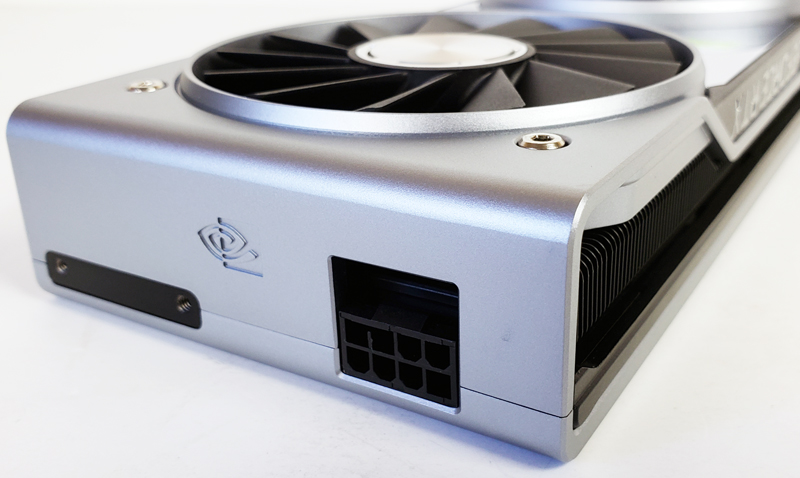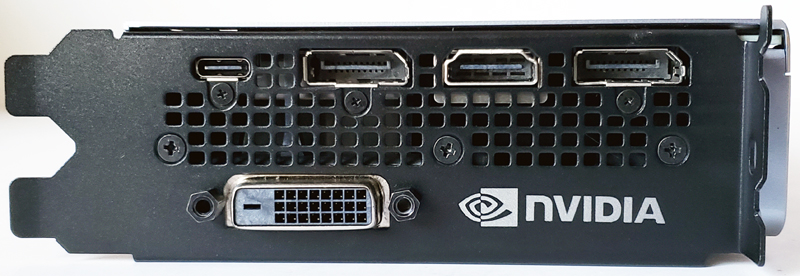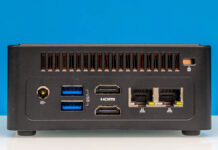Recently, NVIDIA launched its “Super” line of GPUs to counter the new AMD Radeon “Navi” generation of GPUs. Competition in the market means that we get upgraded GPUs for the desktop. While the majority of coverage focused on gaming performance of the two cards, at STH, we look at things differently. We focus on compute power and after starting our review, we needed to pause our AMD Radeon RX 5700 XT and RX 5700 review because AMD’s compute stack was not stable enough to complete our benchmark suite. In this NVIDIA GeForce RTX 2060 Super review, we are going to look at the compute performance and some of the gains attributed to 8GB of GDDR6 in this generational update. When it comes to our deep learning and AI benchmarks, that had an expected and important impact.
NVIDIA GeForce RTX 2060 Super Overview
For our NVIDIA GeForce RTX 2060 Super 8GB review, we are using the Founders Edition part from NVIDIA. The front of the NVIDIA GeForce RTX 2060 Super looks very much like the NVIDIA GeForce RTX 2080 Ti we reviewed. It has a very nice metal plate with a mirror finish between the fans. Previous cards had a matte black finish, and now the word “Super” in green appears. Like the other NVIDIA reference cards, the NVIDIA GeForce RTX 2060 SUPER is impressive and shows a very high-quality build.

The NVIDIA GeForce RTX 2060 Super is not a large graphics card, measuring 9” in length, 4.435” tall and 1.5” thick which should fit nicely in compact systems. NVIDIA uses two fans cooling the GPU heatsink.
The back of the NVIDIA GeForce RTX 2060 Super shows a large backplate fitting to the card which aids in cooling and stiffens the card. Again, we see the special “Super” appear in green to let you know this is not a vanilla RTX 2060.

Although we generally prefer blower-style coolers given their ability to pack into dense servers and workstations, there is a feature of this dual fan solution we like. The 8-pin power connector is at the end of the card. Compared to many other cards, this allows better cable management for server and higher-end workstation chassis. We prefer this location to even the ASUS Turbo-RTX2060-6G blower-style unit we reviewed for the original 2060 launch. This should work out great for those who want to install these cards in server cases and use remote terminal functionality to keep a work environment quiet.

Video outputs include 2x DisplayPort 1.4, one HDMI 2.0b, DVI-D, and one USB Type-C port that is used for VR applications.

Large air vents at the back of the NVIDIA GeForce RTX 2060 Super Founders Edition card aid in proper cooling.
Next, let us take a look at the NVIDIA GeForce RTX 2060 Super key specifications and continue on with our performance testing.





Look at that TensorFlow training performance on pg. 5! That’s an insane upgrade over the Rtx 2060 6G. The Titan Rtxs change the chart’s scale but it’s a huge increase at the low end
Are you sure about this “Peak FP32 Compute: 14.2 TFLOPS”?
“A key reason that we started this series was to answer the cooling question.”
If the answer to this is your statement about running equal to other cards, that would not seem to be either a strong endorsement nor conclusive.
Hence I’m curious if it’d be possible to compare the 2060 Super vs. 2070 Blower. From your statement of test setup it appears the chart is single GPU, so perhaps multi-GPU would be closer to real-world. [yeah I know, ‘you guys should go buy 4 of those, a couple of these, some Titans …” etc., and I’ve spent $60k of your money that you don’t have 8]
Remember to use some beefy case fans, or just state what’s being used.
This review was very important to me, ended up demonstrating that the RTX 2060 SUPER is the true entry-level GPU for Machine Learning and Deep Learning. I have the following questions:
Which manufacturer has the best quality plate, greater durability, greater strength to work for long time under full load?
Is it possible to downclock this GPU by reducing its frequency? This is important in ML / DL processing that can last for days under full load, so the GPU does not constantly work overloaded, thereby increasing its lifespan and running the processing with more stability.
Workstation motherboards, in case you have two video cards or an offboard video card and the integrated video processor, such as ASUS Pro WS X570-ACE, ASUS WS C246 PRO, Gigabyte C246-WU4, have in their bios some kind of control in which can I set a card for video driver and another GPU to leave only for ML / DL processing?
Congratulations on the matter. I hope to briefly review the RTX 2070 SUPER.
Why wasnt Vega VII tested in this group?????
@asH
It’s only tested in benchmarks where NVidia is faster, just remember how STH earns their money.
I would love to know how we earn money @Misha? Sure is not from the STH publishing side for the last 10 years. Enlighten me. Seems like you know better than I do given the tone of that comment.
@asH very simple reason. We do not have one to test. If we did, it would be in there.
” ..very simple reason. We do not have one to test. If we did, it would be in there.”
-Then why wasnt that said that in the article?
Wait! Are you then saying you ONLY test cards given to you by manufacturers??
“On the AMD side, the new Navi based parts are unable to complete even half of our test suite due to the compute stack. ”
…Then this statement is a half truth because on the AMD side their compute card, Vega VII (based in MI50/60), the 7nm(25%) big brother to Frontier wasnt tested because you didnt have one. ..Quite an impressive array of cards you did have. Just sayin’
asH asH we tend to present the relevant data we have. For example, when we review a Xeon-based server we usually test with multiple SKUs. We do not test with all 50+ SKUs because it would take too long and we do not have every Xeon SKU.
We buy cards to test from time-to-time. On the other hand, we knew the Radeon VII would have a *very* short lifespan in the market. Given the price tag, our budgets, and expected traffic from a Radeon VII review, we could not buy one. Radeon VII was a very short-lived product.
On the Navi statement, that was based on AMD’s acknowledgment as well that their compute drivers for those cards were not ready yet. No half-truth there.
If you would like to provide a Radeon VII, we are happy to test it just to add to the database. My sense is that you just want to see the now discountinued Radeon VII in these charts.
I am surprised by the low DP FLOPS (FP64) performance for all of these. I know old GPUs had no or hardly any FP64 (like 1:24) but I thought newer cards had ratios like 1:3, or configurable allocations between FP32 and FP64, allowing up to 1:3 ratios. Is there some background to the testing that would clarify this, or are the advertised improvements in FP64 performance just hype?
Dear all,
I am really impressed with the benchmarks and your proffesionalism.
Please do share how to achieve such a high result (6990) in superposition, would really like to know that, or at least to come somewhat close to that (currently breached the 6000 limit).
Thank you in advance.
how could you reach 6990 points in superposition with the rtx 2060 super?
somebody…!
Jason – William just adds what he gets from the output using the test configuration he has. If you have a different configuration, you will likely get something different. We do not have the resources to troubleshoot everyone’s specific configuration.
that is not a 2060 super you are testing. look at your gpu z. the actual gpu and the texture fill rate is off.
and your TMUs